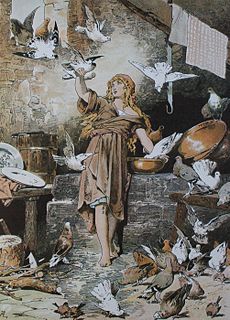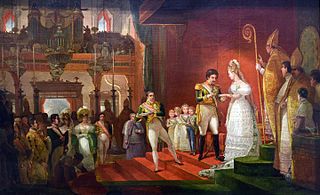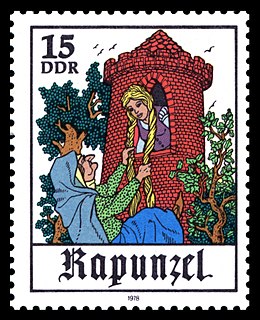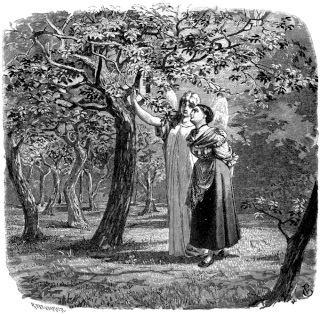Related Research Articles

The Brothers Grimm, Jacob (1785–1863) and Wilhelm (1786–1859), were German academics, philologists, cultural researchers, lexicographers, and authors who together collected and published folklore. They are among the best-known storytellers of folk tales, popularizing stories such as "Cinderella", "The Frog Prince", "Hansel and Gretel", "Little Red Riding Hood", "Rapunzel", "Rumpelstiltskin", "Sleeping Beauty", and "Snow White". Their first collection of folk tales, Children's and Household Tales, began publication in 1812.

"Cinderella", or "The Little Glass Slipper", is a folk tale with thousands of variants throughout the world. The protagonist is a young woman living in forsaken circumstances that are suddenly changed to remarkable fortune, with her ascension to the throne via marriage. The story of Rhodopis, recounted by the Greek geographer Strabo sometime between around 7 BC and AD 23, about a Greek slave girl who marries the king of Egypt, is usually considered to be the earliest known variant of the Cinderella story.

Sleeping Beauty, or Little Briar Rose, also titled in English as The Sleeping Beauty in the Woods, is a classic fairy tale about a princess who is cursed to sleep for a hundred years by an evil fairy, to be awakened by a handsome prince at the end of them. The good fairy, realizing that the princess would be frightened if alone when she awakens, uses her wand to put every living person and animal in the palace asleep, to awaken when the princess does.

A stepmother is a woman who enters one's family by marrying one's parent. Children from her spouse's previous unions are known as her stepchildren.

"Hansel and Gretel" is a German fairy tale collected by the German Brothers Grimm and published in 1812 in Grimm's Fairy Tales. It is also known as Hansel and Grettel, or Little Step Brother and Little Step Sister.

Rapunzel is a German fairy tale recorded by the Brothers Grimm and first published in 1812 as part of Children's and Household Tales. The Brothers Grimm's story is an adaptation of the fairy tale Rapunzel by Friedrich Schulz (1790) that was a translation of Persinette (1698) by Charlotte-Rose de Caumont de La Force, which was itself influenced by an earlier Italian tale, Petrosinella (1634), by Giambattista Basile.

"The Goose Girl" is a German fairy tale collected by the Brothers Grimm and first published in Grimm's Fairy Tales in 1815. It is of Aarne-Thompson type 533.

Grimms' Fairy Tales, originally known as the Children's and Household Tales, is a German collection of fairy tales by the Grimm brothers or "Brothers Grimm", Jacob and Wilhelm, first published on 20 December 1812. This first edition contained 86 stories, and by the seventh edition in 1857, it had 210 unique fairy tales.

"The Juniper Tree" is a German fairy tale published in Low German by the Brothers Grimm in Grimm's Fairy Tales in 1812. The story contains themes of child abuse, murder, cannibalism and biblical symbolism and is one of the Brothers Grimm's darker and more mature fairy tales.

"The Three Little Men in the Wood" or "The Three Little Gnomes in the Forest" is a German fairy tale collected in 1812 by the Brothers Grimm in Grimm's Fairy Tales. Andrew Lang included it in The Red Fairy Book (1890) as "The Three Dwarfs," and a version of the tale appears in A Book of Dwarfs (1964) by Ruth Manning-Sanders.
"Mother Trudy" is a German fairy tale collected by the Brothers Grimm, tale number 43. It is Aarne-Thompson type 334, at the witch's house.

"The Girl Without Hands" or "The Handless Maiden" or "The Girl With Silver Hands" or "The Armless Maiden" is a German fairy tale collected by the Brothers Grimm. It is tale number 31 and was first published in the 1812 edition of Children's and Household Tales. The story was revised by the Grimm brothers over the years, and the final version was published in the 7th edition of Children's and Household Tales in 1857. It is Aarne-Thompson type 706.
"The Willful Child" is a German fairy tale collected by the Brothers Grimm as tale number 117. As a legend, it is widely distributed in Germany.
The Goat-faced Girl is an Italian fairy tale. Giambattista Basile included a version in his Pentamerone (1634-1636). Andrew Lang included a version, collected by Hermann Kletke, in The Grey Fairy Book (1900).

"The Twelve Brothers" is a German fairy tale collected by the Brothers Grimm in Grimm's Fairy Tales. Andrew Lang included it in The Red Fairy Book.
"The True Bride" or "The True Sweetheart" is a German fairy tale collected by the Brothers Grimm in Grimm's Fairy Tales as tale 186.
"The Pink" or "The Carnation" is a German fairy tale collected by the Brothers Grimm in Grimm's Fairy Tales as tale number 76.

"Mary's Child" is a German fairy tale collected by the Brothers Grimm in Grimm's Fairy Tales in 1812. It is of Aarne-Thompson type 710.
"Saint Solicitous", is a story first published as no. 66 of Grimm's Fairy Tales. Although included in the first edition in 1815, it was dropped in the second edition (1819) because it bore too much resemblance to Ovum paschale Neugefärbte Oster-Ayer, a legend by Andreas Strobl. Strobl's legend appears to be based on the popular medieval cult of Saint Wilgefortis.

"Sweet Porridge", often known in English under the title of "The Magic Porridge Pot", is a folkloric German fairy tale recorded by the Brothers Grimm, as tale number 103 in Grimm's Fairy Tales, in the 19th century. It is Aarne–Thompson–Uther type 565, the magic mill. Other tales of this type include Why the Sea Is Salt and The Water Mother.
References
- ↑ Jacob and Wilheim Grimm, Household Tales, "The Maid of Brakel"
- ↑ D.L. Ashliman, "The Grimm Brothers' Children's and Household Tales (Grimms' Fairy Tales)"